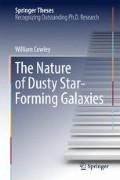Abstract
One of the main goals of the study of galaxy formation and evolution is to understand the star formation history of the Universe.
Access this chapter
Tax calculation will be finalised at checkout
Purchases are for personal use only
Notes
- 1.
The content of this Chapter is based on the article Cowley et al. ‘Simulated observations of sub-millimetre galaxies: the impact of single-dish resolution and field variance’, Monthly Notices of the Royal Astronomical Society, Volume 446, Issue 2, p. 1784–1798, published 21 November 2014. Reproduced with permission. All rights reserved, https://doi.org/10.1093/mnras/stu2179.
- 2.
These authors surveyed 87 deg\(^2\) at 1.4 (2) mm to a depth of 11 (4.4) mJy with a 63\(''\) (69\(''\)) FWHM beam. Due to the flux limits and wavelength of this survey, the millimetre detections are mostly gravitationally lensed sources (Vieira et al. 2013).
- 3.
As of September 2014. Larger surveys have now been completed (e.g. Geach et al. 2017).
- 4.
In practise our surveys are 0.55 deg\(^2\). This allows for galaxies outside the 0.5 deg\(^2\) area to contribute to sources detected inside this area after convolution with the single-dish beam.
- 5.
We use the \(\sigma \) of our match-filtered PSF i.e. \(\sqrt{2}\times \mathrm {FWHM}/2\sqrt{2\ln {2}} \approx 9''\), and choose \(4\sigma \) so that the search radius is large enough for our results in this Section to have converged after our flux weighting scheme has been applied.
- 6.
In the sense that it begins at high redshift (\(z\gtrsim 20\)).
- 7.
We re-calculate the ‘effective’ area of our follow-up surveys as 0.35 deg\(^2\) \(\times N_\mathrm{{Good\,ALMA\,Maps}}/N_\mathrm{LESS\, Sources}\approx 0.25\) deg\(^2\) as in Karim et al. (2013).
- 8.
Three of the 99 SMGs presented in Hodge et al. (2013) lay on the edge of ECDFS with coverage in only two IRAC bands, and so were not considered further in Simpson et al. (2014).
- 9.
Aztronomical Thermal Emission Camera/Atamaca Sub-millimetre Telescope Experiment.
- 10.
450 \(\upmu \)m galaxies at high redshift (\(z\gtrsim 5.5\)) have \(\lambda _\mathrm{rest}<70\) \(\upmu \)m and therefore the sub-mm flux calculated by our dust model may be systematically incorrect when compared to grasil predictions (see Sect. 2.9 and Appendix C). We expect the contribution of such galaxies to our 450 \(\upmu \)m population to be small.
- 11.
These flux limits were motivated by the median flux ratios of our lightcone galaxies of \(S_{1100\,\upmu \mathrm {m}}/S_{850\,\upmu \mathrm {m}}\approx 0.5\) and \(S_{850\,\upmu \mathrm {m}}/S_{450\,\upmu \mathrm {m}}\approx 0.3\).
Author information
Authors and Affiliations
Corresponding author
Rights and permissions
Copyright information
© 2017 Springer International Publishing AG
About this chapter
Cite this chapter
Cowley, W. (2017). Simulated Observations of Sub-millimetre Galaxies: The Impact of Single-Dish Resolution and Field Variance. In: The Nature of Dusty Star-Forming Galaxies. Springer Theses. Springer, Cham. https://doi.org/10.1007/978-3-319-66748-5_3
Download citation
DOI: https://doi.org/10.1007/978-3-319-66748-5_3
Published:
Publisher Name: Springer, Cham
Print ISBN: 978-3-319-66747-8
Online ISBN: 978-3-319-66748-5
eBook Packages: Physics and AstronomyPhysics and Astronomy (R0)

